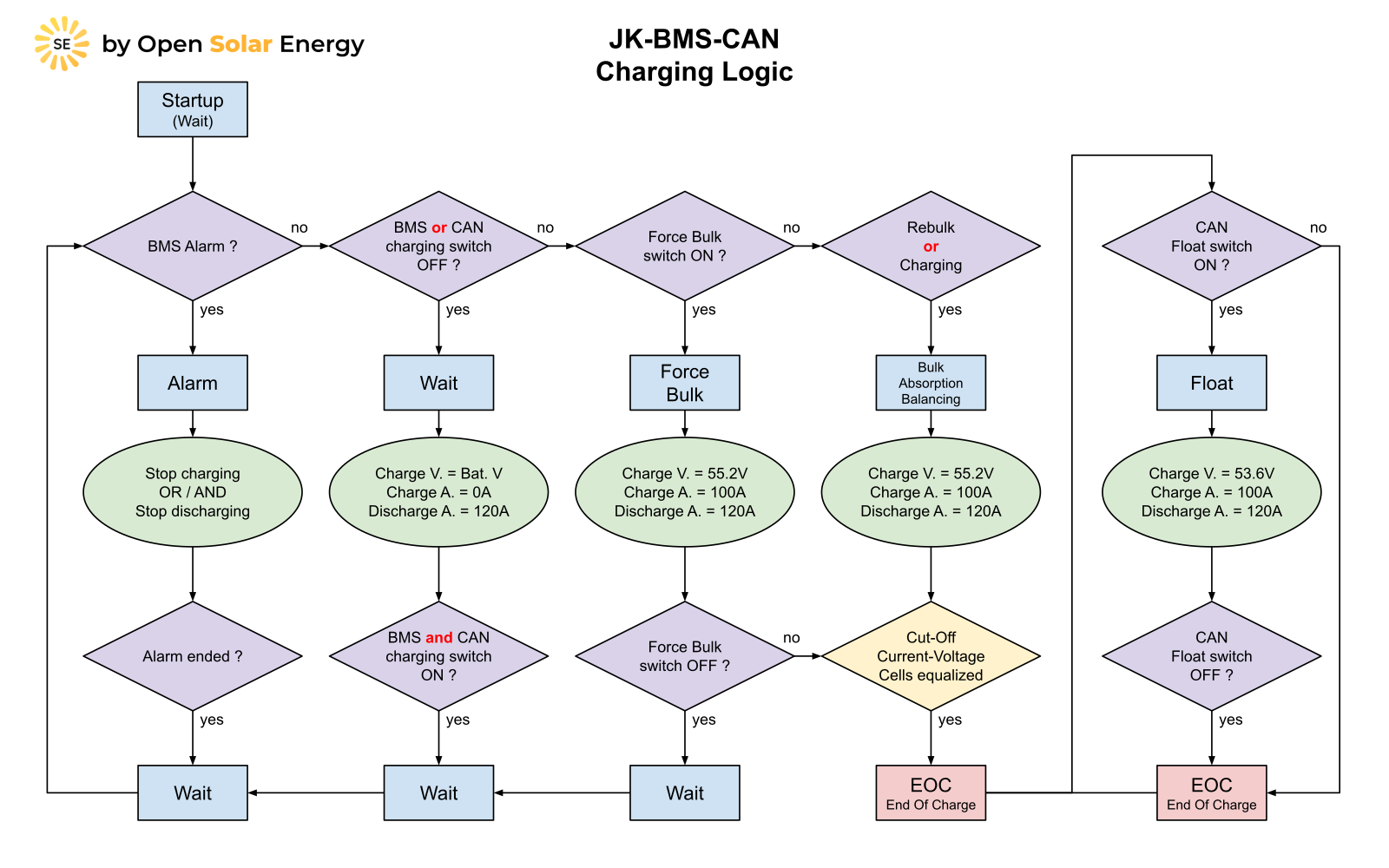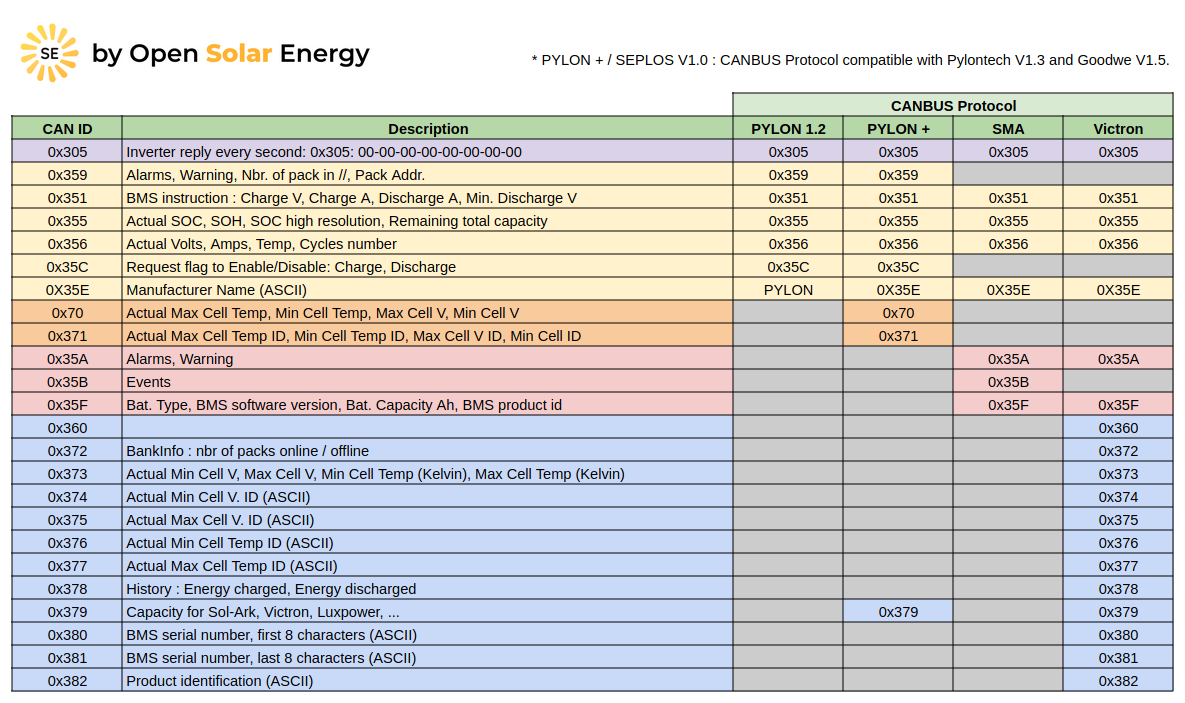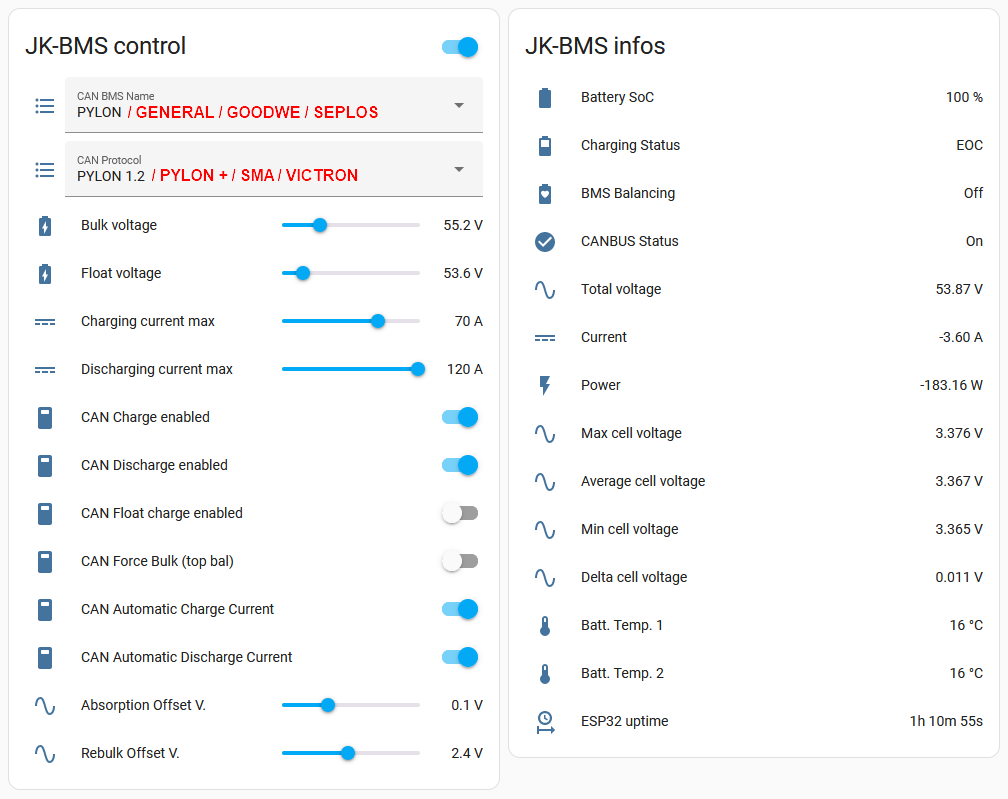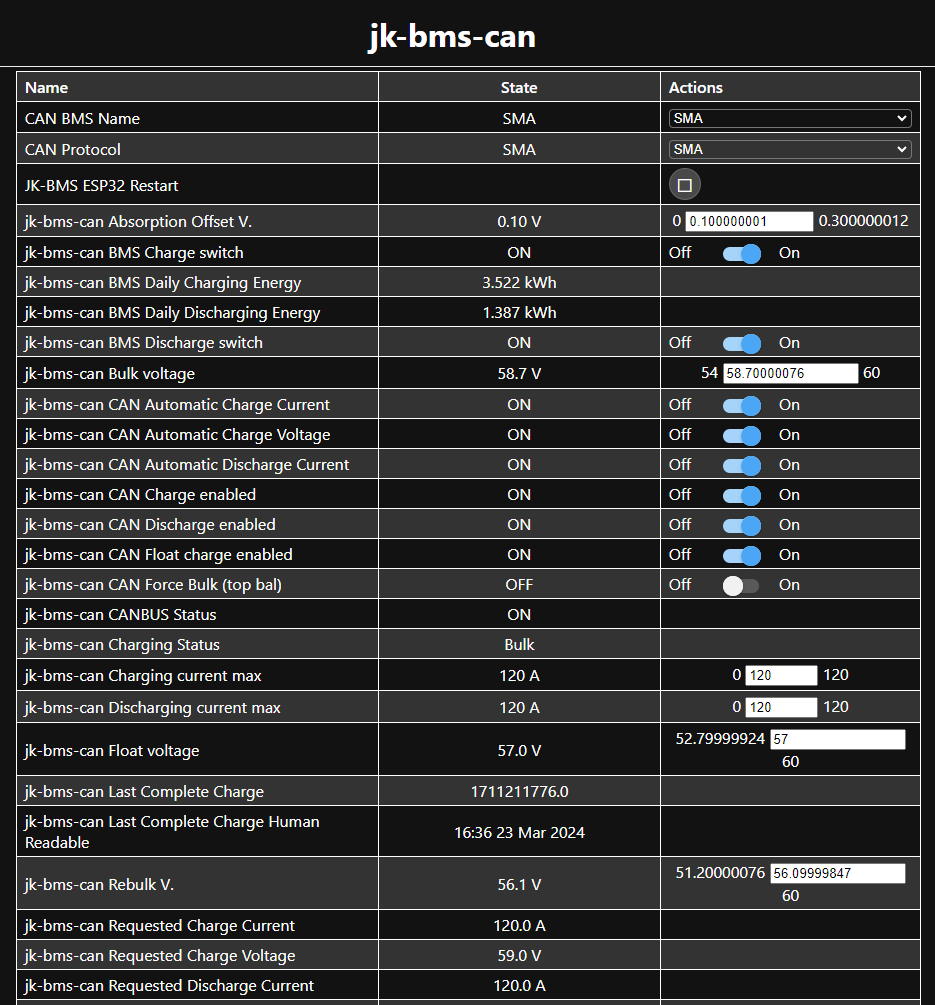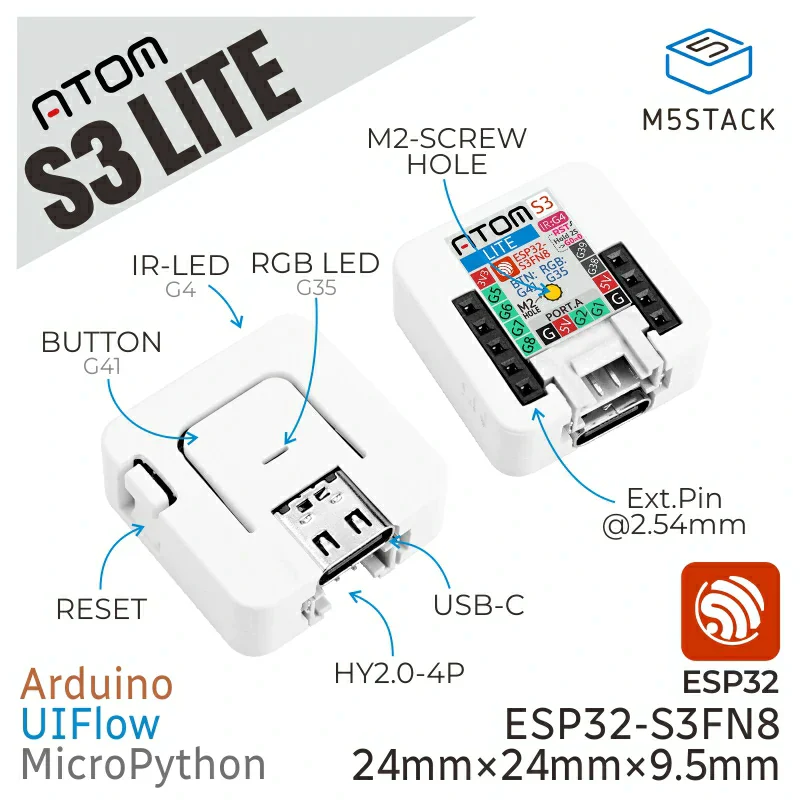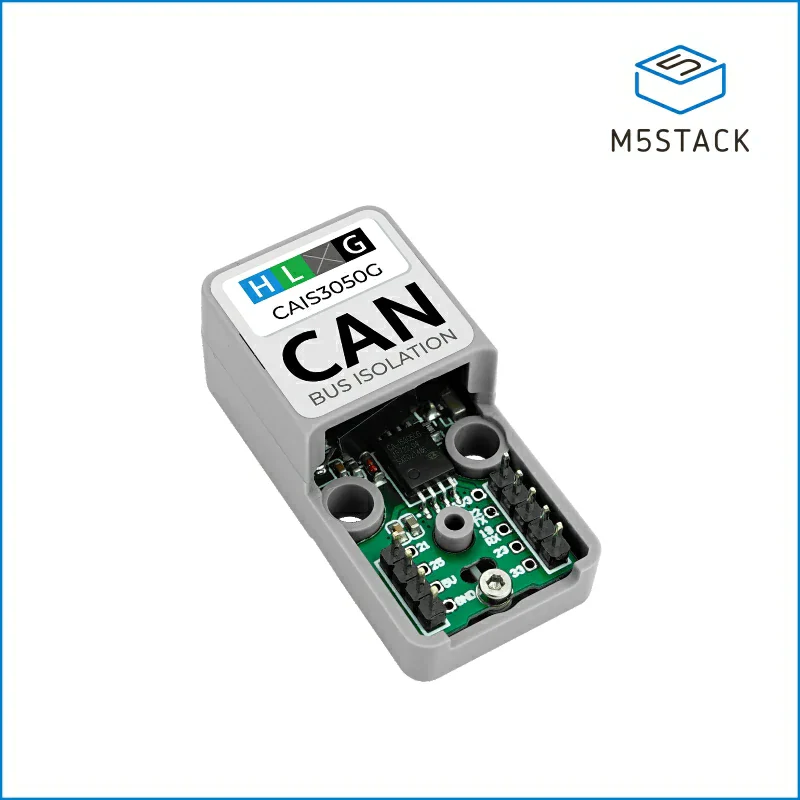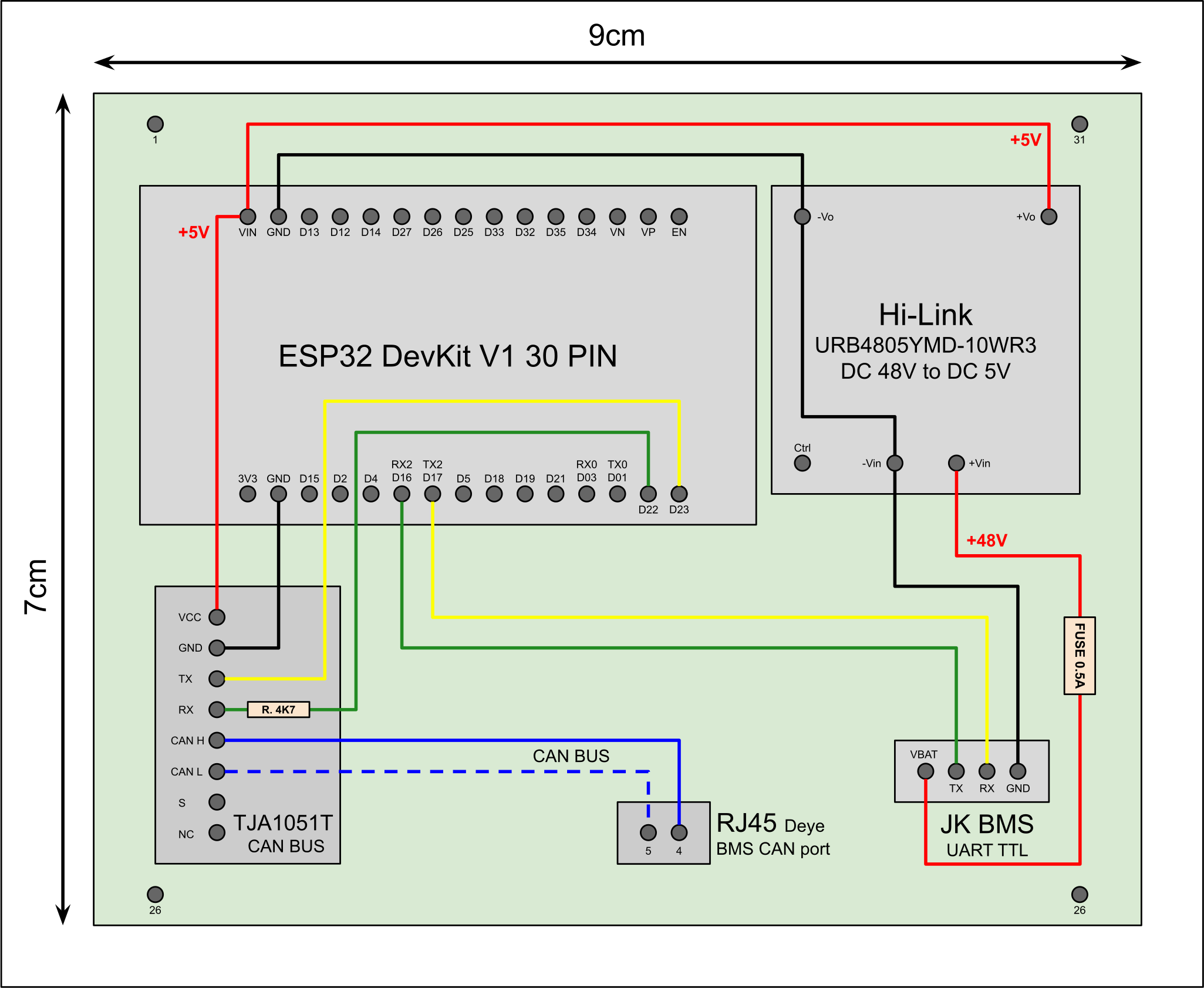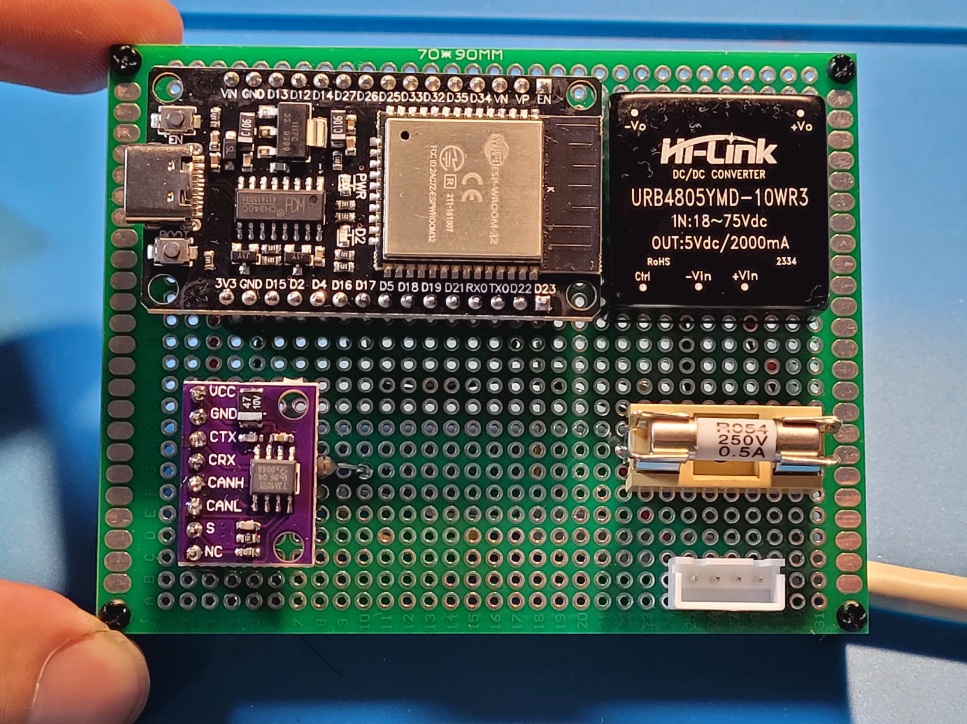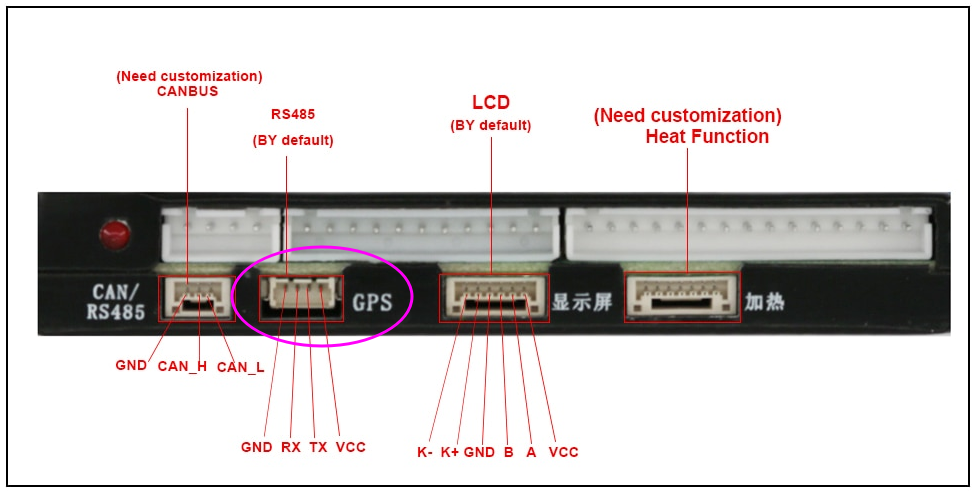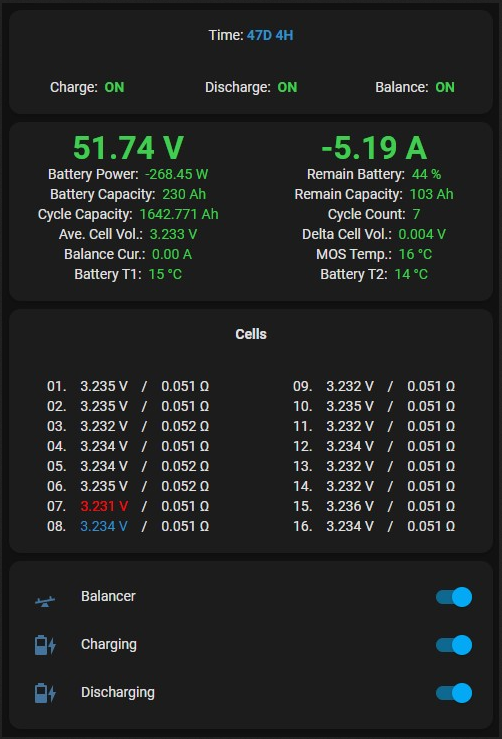ESPHome component to monitor a Jikong Battery Management System (JK-BMS) and communicate with inverters supporting CAN bus protocol compatible with Pylontech, GoodWe, Seplos, SMA or Victron.
Note: Pylontech uses 15s/48v and many others uses 16s/51.2v @3.2v/cell nominal. Other battery profiles that utilise the PYLON protocol with different cell counts may also work, eg Alpha Ess Smile, BYD Battery-Box LV Flex Lite. Select the correct battery profile in the inverter to match your battery pack!
The ESP32 communicates with the JK-BMS using the RS485 port (GPS) which is in fact not RS485 but 3.3V UART-TTL, so it can be directly connected to the ESP32. The ESP32 then sends the required CAN bus data to the inverter via a TJA1050, TJA1051T or SN65HVD230 CAN bus transceiver.
Note: some inverters only accept a CAN bus at 3.3V in this case please choose the SN65HVD230 chip.
Sends over CAN bus to inverter:
- Battery Voltage
- Battery Current (+charge, -discharge)
- State of Charge (SOC)
- State of health (SOH)
- BMS Temperature
- Charging Voltage
- Charging Amps
- Discharge min Voltage
- Battery name
- Alarms: Cell over/under voltage, Charge/discharge over current, High/low Temp, BMS fault
Note: This code support only one BMS connection per inverter and should work with inverters that support the CAN bus protocol shown in the table below.
I'm only testing it with my Deye SUN-6K-SG03-LP1-EU inverter.
The CAN bus support is still in development and testing...
Dedicated topic on DIY Solar Forum
The charging voltage and current correspond to the default values in the YAML script and can be modified.
When Auto Charge / Discharge Current or Auto Charge Voltage are enabled, these default values will be automatically adjusted based on cell voltages.
Cut-Off Charging Logic (what's happening in the yellow diamond)
Auto Charge Voltage Logic
Note: the following IDs are not implemented: 0x35B, 0x360, 0x378, 0x380 and 0x381.
If your ESP32 is not connected with Home Assistant it will reboot every 15 minutes. This is the normal behavior of ESPHome if HA is not connected to the ESP32 API. This is not a bug to be resolved but a mechanism put in place by the ESPHome team to correct a possible problem with the API connection.
The "api:" section is therefore configured by default not to reboot every 15 minutes if Home Assistant is not connected.
# +------------------------------------------------------------------+
# | ** The settings below can be modified according to your needs ** |
# +------------------------------------------------------------------+
api:
reboot_timeout: 0sIf you don't use Home Assistant, you can activate the web server and have access to information coming from JK-BMS and also interact with the application.
The web server is not enabled by default.
To enable this feature, uncomment the lines below in your YAML file.
# +------------------------------------------------------------------+
# | ** The settings below can be modified according to your needs ** |
# +------------------------------------------------------------------+
web_server:
port: 80
log: false
ota: false
By default, if the ESP32 is disconnected from the WiFi network it will reboot every 15 minutes to try to resolve the problem.
If you don't want to connect the ESP32 to the WiFi network please remove the lines below in your YAML file.
# +------------------------------------------------------------------+
# | ** The settings below can be modified according to your needs ** |
# +------------------------------------------------------------------+
wifi:
ssid: !secret wifi_ssid
password: !secret wifi_password
domain: !secret domain- v1.17.5 MrPablo : "Auto Charge Voltage Control" function rewritten, EOC cycle threshold added to reduce premature triggering of float phase
- V1.17.4 MrPablo : Added "SMA" to CAN BMS names, added function "Auto Charge Voltage Control" to avoid OVP alarms and improve balancing, categorised sensors, set time source to SNTP, min battery voltage based on BMS value, added "Last Complete Charge" timestamp, renamed daily energy sensors and added input number display option
- V1.17.3 Sleeper85 : Renumbering cells, Added “BMS Charging”, “BMS Discharging” and “JK-BMS ESP32 Restart” switches, adding Total Daily Energy sensors, set jk_bms update interval to 3s, set default log level to INFO, improvement of comments
- V1.17.2 MrPablo : Added function "Auto Charge/Discharge Current Control" to avoid OVP/UVP alarms
- V1.17.1 Sleeper85 : New Cut-Off Current/Voltage Charging Logic for LFP with the participation of @shvmm
- V1.16.6 Sleeper85 : Selectable CAN settings + Adding inverter_offset_v + Improved CAN ID 0x355, sending 100% only at the end of the absorption phase, adding bytes [04:05] and [06:07] + Automatic calculation of the number of battery modules + Save and Restore slider values
- V1.16.5 Sleeper85 : Add Preventive Alarms Logic, CAN ID 0x356: send average temperature of T1/T2, new "Discharging current max" slider
- V1.16.4 Sleeper85 : Improved Charging Logic for ESP32 startup/reboot and Float charge, Add CAN ID 0x356 bytes [06:07] cycles for Sofar, Change switch name
- V1.16.3 Sleeper85 : ID 0x379 will be sent when choosing protocol 2 or 4 (Battery Capacity for Victron, Sol-Ark and Luxpower)
- V1.16.2 Sleeper85 : Split the "Charge/Discharge values" section and added instructions for "Stop Discharging" + Change framework to "esp-idf" (BLE version)
- V1.16.1 Sleeper85 : Slider charging_current max value = ${charge_a}, Improved Alarm/Charging/Discharging Logic, Improved CAN protocol and Victron support
- V1.15.5 Sleeper85 : Improved code and set api "reboot_timout" to "0s" by default (no reboot without HA)
- V1.15.4 Sleeper85 : Improved documentation for API, Web Server and WiFi settings
- V1.15.3 Sleeper85 : Add 'CAN Protocol Settings' and new CAN ID based on the SMA and Victron protocol (alpha)
- V1.15.2 Sleeper85 : Improved Alarm handling, all alarms will set charge/discharge current to 0A and set 'Charging Status' to Alarm
- V1.15.1 Sleeper85 : New CANBUS script with CANBUS Status in HA, stop sending CAN messages if the inverter is not responding (fix WDT reboot issues).
- V1.14.3 Sleeper85 : Improved documentation + Charging Voltage tips for Deye
- V1.14.2 Sleeper85 : Improve 'Charging Voltage' behavior
- V1.14.1 Sleeper85 : Add 'Float charge function'
- V1.13.6 Sleeper85 : Add 'Absorption time' and 'Absorption Offset V.' slider
- V1.13.5 Sleeper85 : Set CAN manufacter to "PYLON" for improve compatibility with Deye and other inverters
- V1.13.4 Sleeper85 : Improve 'Charge Status' behavior + add 'Rebulk Offset V.' slider
- V1.13.3 uksa007 : Improve compatibility with Deye and other inverters
- V1.13.2 uksa007 : Send Max Temperature of T1, T2 to inverter
- V1.13.1 uksa007 : Fix compile issues with new version of ESPhome 2023.4.0, set rebulk offset to 2.5
Inverters supporting CAN PYLON/Goodwe/SMA/Victron Low Voltage protocol should work, check your inverter manual to confirm.
The following are confirmed and known to work:
| Brand | Model | Satus | Reported by | Inverter battery | CAN name | CAN protocol | CAN board | Remarks |
|---|---|---|---|---|---|---|---|---|
| Deye | SUN-6K-SG03LP1-EU | Working | @Sleeper85 | Lithium 00 | PYLON | PYLON 1.2 | TJA1051T | --- |
| Deye | SUN-5K-SG03LP1-EU | Working | @vdiex | Lithium 00 | PYLON | PYLON 1.2 | --- | --- |
| Deye | SUN-12K-SG04LP3-EU | Working | @lucize | Lithium 00 | PYLON | PYLON 1.2 | --- | --- |
| Deye | SUN-3.6K-SG03LP1-EU | Working | @Der_Hannes | Lithium 00 | PYLON | PYLON 1.2 | SN65HVD230 3.3V | --- |
| Goodwe | 3648-ES (GW5048-ES) | Working | @jirdol | --- | GOODWE | PYLON + | --- | --- |
| Goodwe | GW5000S-BP | Working | @Uksa007 | Goodwe LX U5.4-L | GOODWE | PYLON + | --- | --- |
| Goodwe | GW5000S-BP & GW3600S-BP | Working | @OselDusan7 | --- | GOODWE | PYLON + | --- | --- |
| Sofar | ME 3000-SP | Working | @starman | --- | --- | --- | --- | --- |
| Sofar | HYD 5000-ES | Working | @Paulfrench35 | --- | --- | --- | --- | --- |
| Sofar | HYD 5000-EP | Working | @tonystrullu | --- | --- | --- | --- | --- |
| Growatt | SPF 5000ES | Working | @Paulfrench35 | CAN L52 | PYLON | PYLON 1.2 | --- | --- |
| Growatt | SPF 5000ES | Working | @cjdell | CAN L52 | PYLON | PYLON 1.2 | --- | --- |
| Solis | RHI-3.6K-48ES-5G | Working | @cjdell | Pylon LV | PYLON | PYLON + | SN65HVD230 3.3V | --- |
| Solis | S5-EH1P4.6K-L | Working | @Baker0052 | Pylon LV | PYLON | PYLON + | --- | --- |
| Solis | S5-EH1P6K-L | Working | @MrPabloUK | AoBo | SMA | SMA | Adafruit CAN Pal | --- |
| Solis | RHI-3.6K-48ES-5G | Working | @MrPabloUK | AoBo | SMA | SMA | Adafruit CAN Pal | --- |
| LuxPower | LXP SNA 5K | Working | @shvmm | Li 02 | PYLON | PYLON + | SN65HVD230 3.3V | --- |
| --- | Turbo Energy | Working | @ibikku | --- | --- | --- | --- | --- |
| SMA | Sunny Island | --- | --- | --- | --- | --- | --- | --- |
| Victron | --- | --- | --- | --- | --- | --- | --- | --- |
All JK-BMS models with software@ version >=6.0 are using the implemented protocol and should be supported.
See the @syssi esphome-jk-bms repository for more information.
- ESPHome 2022.11.0 or higher.
- Generic ESP32 DevKit v1 30 pin board or M5Stack Atom Lite (ESP32-PICO)
- NOTE: ESP32-S2 currently has issues with CAN BUS and does not work!
- For 5V CAN bus : TJA1050 or TJA1051T CAN controller interface module and 4.7K resistor for 5v to 3.3v level shifing.
- For 3.3V CAN bus : SN65HVD230 CAN controller interface module without 4.7K resistor
- For Atom CAN bus : M5Stack ATOMIC CANBus Base (CA-IS3050G)
- Optional: 48V to 5V DC-DC converter to power the ESP32 from the JK-BMS VBAT pin (URB4805YMD-10WR3 or VRB4805S-6WR3)
- Optional: JK RS485 Adaptor and RS484 to TTL3.3v Adaptor (see optional schematic below)
If soldering or creating your own board seems complicated to you, know that it is possible to use the Atom CAN Kit from M5Stack.
Recommended: Atom S3 Lite + Atomic CAN Base
This is an example of an ESP32 DevKit v1 30 pin board powered by the BMS.
If you don't want to connect a wire between the BMS and the ESP32 choose the Bluetooth version => esp32_ble_jk-bms-can.yaml
If you prefer to use a wired connection between the BMS and the ESP32 choose the Wire version => esp32_wire_jk-bms-can.yaml
Atom S3 Lite (ESP32-S3)
Note: Follow the configuration instructions in the config_atom-s3-lite-esp32-s3.yaml file (config folder).
UART-TTL RS232-TTL CAN BUS
┌──────────┐ ┌──────────┐ ┌────────────┐ ┌──────────┐
│ │<TX------RX>│2 5│<TX-------TX>| | | |
│ JK-BMS │<RX------TX>│1 6│<RX-------RX>| CA-IS3050G |<---CAN H --->| Inverter |
│ │<----GND--->│ ESP32 │ | CAN |<---CAN L --->| |
│ │ 5V---->│5V 3V3| | | | |
└──────────┘ └──────────┘ └────────────┘ └──────────┘
Atom Lite (ESP32-PICO)
Note: Follow the configuration instructions in the config_atom-lite-esp32-pico.yaml file (config folder).
UART-TTL RS232-TTL CAN BUS
┌──────────┐ ┌──────────┐ ┌────────────┐ ┌──────────┐
│ │<TX------RX>│26 22│<TX-------TX>| | | |
│ JK-BMS │<RX------TX>│32 19│<RX-------RX>| CA-IS3050G |<---CAN H --->| Inverter |
│ │<----GND--->│ ESP32 │ | CAN |<---CAN L --->| |
│ │ 5V---->│5V 3V3| | | | |
└──────────┘ └──────────┘ └────────────┘ └──────────┘
Generic ESP32 DevKit v1 30 pin
Note: Follow the configuration instructions in the config_generic-esp32-devkit-v1.yaml file (config folder).
3.3V CAN BUS
UART-TTL RS232-TTL CAN BUS (3V3)
┌──────────┐ ┌──────────┐ ┌────────────┐ ┌──────────┐
│ │<TX------RX>│16 23│<TX-------TX>| | | |
│ JK-BMS │<RX------TX>│17 22│<RX-------RX>| SN65HVD230 |<---CAN H --->| Inverter |
│ │<----GND--->│ ESP32 │<----GND---->| CAN |<---CAN L --->| |
│ │ 5V---->│VIN 3V3│<---3.3V---->| | | |
└──────────┘ └──────────┘ └────────────┘ └──────────┘
5V CAN BUS
UART-TTL RS232-TTL CAN BUS (5V)
┌──────────┐ ┌──────────┐ ┌────────────┐ ┌──────────┐
│ │<TX------RX>│16 23│<TX-------TX>| | | |
│ JK-BMS │<RX------TX>│17 22│<RX--4K7--RX>| TJA1050 |<---CAN H --->| Inverter |
│ │<----GND--->│ ESP32 │<----GND---->| CAN |<---CAN L --->| |
│ │ 5V---->│VIN VIN│<----5V----->| | | |
└──────────┘ └──────────┘ └────────────┘ └──────────┘
Schématic with addition of the UART-TTL to RS485 adapter sold by JK-BMS
UART-TTL RS485 RS485-TTL RS232-TTL CAN BUS
┌──────────┐ ┌───────────┐ ┌────────┐ ┌─────────┐ ┌─────────┐ ┌──────────┐
│ │<----TX---->│Y JK Y│<A------A+>│ │<TX-----RX>│16 23│<TX-------TX>| | | |
│ JK-BMS │<----RX---->│W RS485 W│<B------B->│ RS485 │<RX-----TX>│17 22│<RX--4K7--RX>| TJA1050 |<---CAN H --->| Inverter |
│ │<----GND--->│B Adaptor B│<---GND--->│To 3.3V │<---GND--->| |<----GND---->| CAN |<---CAN L --->| |
│ │<----VBAT-->│R │ │ │<---3.3V-->| ESP32 |<----5V----->| | | |
└──────────┘ └───────────┘ └────────┘ └─────────┘ └─────────┘ └──────────┘
JK-BMS UART-TTL GPS port
# UART-TTL GPS port on JK-BMS (4 pin, JST 1.25mm pitch)
┌─── ─────── ────┐
│ │
│ O O O O │
│GND RX TX VBAT│
└────────────────┘
│ │ │ | VBAT is full battery volatge eg 51.2V (No connect)
│ │ └──── ESP32 (`rx_pin`)
│ └──────── ESP32 (`tx_pin`)
└──────────── GND
The UART-TTL (labeled as RS485) socket of the BMS can be attached to any UART pins of the ESP.
A hardware UART should be preferred because of the high baudrate (115200 baud).
The connector is called 4 pin JST with 1.25mm pitch.
This YAML file is based on the @syssi esphome-jk-bms repository.
external_components:
- source: github://syssi/esphome-jk-bms@mainInstallation procedure:
-
Install ESPHome on your computer
Before you can flash the YAML file you need to install the esphome application (command line).
Follow these instructions for installation on Windows, Mac or Linux. -
Download YAML files to your computer
You can do this from the command line or in your preferred method.
# Clone this external component
git clone https://github.com/Sleeper85/esphome-jk-bms-can.git
cd esphome-jk-bms-can- Enter your WiFi credentials in the secrets.yaml files
wifi_ssid: YourSSID
wifi_password: YourPassword
domain : .local- Install the application in the ESP32
This is an installation example of YAML Wire for LFP.
Validate the configuration, create a binary, upload it, and start logs.
# To install the Wire version
esphome run ESP32_LFP_Wire_jk-bms-can.yaml
# To install the Bluetooth version
esphome run ESP32_LFP_Wire_jk-bms-can.yaml- Optional: add the ESP32 in Home Assistant
In Home Assistant under " Settings > Devices and services > Add Intergration " select ESPHome add device jk-bms-can if found or supply ip address of ESP32.
# test the config
esphome config ESP32_LFP_Wire_jk-bms-can.yaml
# install the config in ESP32
esphome run ESP32_LFP_Wire_jk-bms-can.yaml
# check the logs (the --device option is not required)
esphome logs ESP32_LFP_Wire_jk-bms-can.yaml --device 192.168.x.x- Fixed in version 1.15.1 -
ESP32 has a bug that causes WDT reboot if no other devices on CAN bus to ACK the packets. If you try to run without inverter it will not work as it will constantly WDT reboot! - The battery type sensor is pretty useless because the BMS reports always the same value (
Ternary Lithium). Regardless of which battery type was set / parameter set was loaded via the android app. (#9) - ESP32: Adding all supported sensors can lead to a stack overflow / boot loop. This can be solved by increasing the stack size. (#63)
A user of the @syssi esphome-jk-bms project (@dr3amr) shared some Home Assistant Lovelace UI cards for a beautiful dashboard here.
If this component doesn't work out of the box for your device please update your configuration to enable the debug output of the UART component and increase the log level to the see outgoing and incoming serial traffic:
logger:
level: DEBUG
uart:
id: uart_0
baud_rate: 115200
rx_buffer_size: 384
tx_pin: ${tx_pin}
rx_pin: ${rx_pin}
debug:
direction: BOTH
- https://www.patreon.com/Uksa007Codedevelopment Thanks to @uksa007 for making the original CAN code.
- https://github.com/syssi/esphome-jk-bms Thanks go to @syssi for help and making the original RS485 code.





